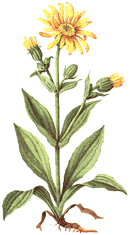
Arnica
Introduction
This fact sheet provides basic information about the perennial plant arnica. Arnica is endemic to Europe, from southern Iberia to southern Scandinavia and the Carpathians. It is absent from the British Isles and the Italian and Balkan Peninsulas. Arnica flowers have been used in liniment and ointment preparations used for strains, sprains, bruises or joint problems.
Common Names
Arnica, Leopard's Bane, Mountain Tobacco, Mountain Snuff, Wolf's Bane
Latin Names
Arnica montana
What It Is Used For
- Arnica is used topically for a wide range of conditions, including bruises, sprains, muscle aches, wound healing, superficial phlebitis, rheumatic pain, inflammation from insect bites, and swelling due to fractures.
- Homeopathic preparations are also used to treat sore muscles, bruises, and other conditions caused by overexertion or trauma.
How It Is Used
Fresh or dried flower heads are used in medicinal preparations.
What the Science Says
- Currently, the U.S. Food and Drug Administration (FDA) has declared arnica an unsafe herb due to adverse effects associated when ingested orally. In contrast, the German market offers over 100 preparations of arnica to its consumers. In Canada, arnica is not allowed for use as a non-medicinal ingredient for oral (by mouth) use products.
Side Effects and Cautions
- Arnica irritates mucous membranes and causes stomach pain, diarrhea, and vomiting.
- The plant is poisonous and ingestion may cause stomach pain, diarrhea and vomiting, dyspnea, cardiac arrest, and death.
Sources







